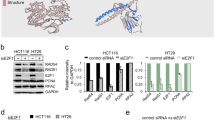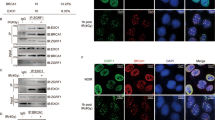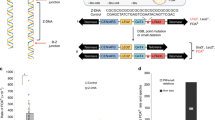Abstract
As one of a number of p53-regulated genes, Gadd45a (growth arrest and DNA damage inducible gene) has been shown to delay carcinogenesis and decrease mutation frequency. Gadd45a is known to regulate nucleotide excision DNA repair (NER) in response to UV radiation. Here, we report an emerging role for Gadd45a in base excision repair (BER). Gadd45a-null mouse embryo fibroblasts MEF and gadd45a-deficient human colon cancer cells exhibited slow BER after treatment with methyl methanesulfonate (MMS) a pure base-damaging agent. In addition, removal of AP sites by apurinic/apyrimidinic endonuclease 1/redox factor 1 (APE1/Ref1) was significantly delayed in gadd45a-null cells. Moreover, the localization of APE1/Ref1 within the nucleus was observed in gadd45a wild-type cells, whereas APE1 become mainly distributed in the cytoplasm, and there is a reduced interaction with proliferating cell nuclear antigen (PCNA) in Gadd45a-deficient cells. Inasmuch as p53 has been shown to regulate BER in addition to the NER pathway, our data suggest that p53-regulated gene Gadd45a contributes to the BER response by affecting the interaction of cellular APE1/Ref1 with PCNA. Gadd45a might be a key component gene of the p53 pathway involved in protection from carcinogenic base damage and maintenance of genomic stability, although the downstream mechanism including APE1/Ref1 will need further study.
This is a preview of subscription content, access via your institution
Access options
Subscribe to this journal
Receive 50 print issues and online access
$259.00 per year
only $5.18 per issue
Buy this article
- Purchase on Springer Link
- Instant access to full article PDF
Prices may be subject to local taxes which are calculated during checkout






Similar content being viewed by others
Abbreviations
- AP sites:
-
apurinic/apyrimidinic sites
- APE1/Ref1:
-
apurinic/apyrimidinic endonuclease 1/redox factor 1
- BER:
-
base excision repair
- MMS:
-
methyl methanesulfonate
- NER:
-
nucleotide excision DNA repair
- PCNA:
-
proliferating cell nuclear antigen
References
Aboussekhra A, Wood RD . (1995). Detection of nucleotide excision repair incisions in human fibroblasts by immunostaining for PCNA. Exp Cell Res 221: 326–332.
Adimoolam S, Ford JM . (2002). p53 and DNA damage-inducible expression of the xeroderma pigmentosum group C gene. Proc Natl Acad Sci USA 99: 12985–12990.
Bae I, Smith ML, Sheikh MS, Zhan Q, Scudiero DA, Friend SH et al. (1996). An abnormality in the p53 pathway following gamma-irradiation in many wild-type p53 human melanoma lines. Cancer Res 56: 840–847.
Eller MS, Maeda T, Magnoni C, Atwal D, Gilchrest B . (1997). Enhancement of DNA repair in human skin cells by thymidine dinucleotides: evidence for a p53-mediated mammalian SOS response. Proc Natl Acad Sci USA 94: 12627–12632.
Fan J, Bertino JR . (1999). Modulation of cisplatinum cytotoxicity by p53: effect of p53-mediated apoptosis and DNA repair. Mol Pharmacol 56: 966–972.
Gaiddon C, Moorthy NC, Prives C . (1999). Ref-1 regulates the transactivation and pro-apoptotic functions of p53 in vivo. EMBO J 18: 5609–5621.
Hanson S, Kim E, Deppert W . (2005). Redox factor 1 (Ref-1) enhances specific DNA binding of p53 by promoting p53 tetramerization. Oncogene 24: 1641–1647.
Hartman AR, Ford JM . (2002). BRCA1 induces DNA damage recognition factors and enhances nucleotide excision repair. Nat Genet 32: 180–184.
Hildesheim J, Bulavin D, Anver MR, Alvord G, Hollander MC, Vardanian L et al. (2002). Gadd45a protects against UV irradiation-induced skin tumors, and promotes apoptosis and stress signaling via MAPK and p53. Cancer Res 62: 7305–7315.
Hildesheim J, Fornace Jr AJ . (2002). Gadd45a: an elusive yet attractive candidate gene in pancreatic cancer. Clin Cancer Res 8: 2475–2479.
Hollander MC, Kovalsky O, Salvador JM, Kim KE, Patterson AD, Haines DC et al. (2001). Dimethylbenzanthracene carcinogenesis in Gadd45a-null mice is associated with decreased DNA repair and increased mutation frequency. Cancer Res 61: 2487–2491.
Kearsey JM, Coates PJ, Prescott AR, Warbrick E, Hall PA . (1995). Gadd45 is a nuclear cell cycle regulated protein which interacts with p21Cip1. Oncogene 11: 1675–1683.
Kelley MR, Cheng L, Foster R, Tritt R, Jiang J, Broshears J et al. (2001). Elevated and altered expression of the multifunctional DNA base excision repair and redox enzyme Ape1/ref-1 in prostate cancer. Clin Cancer Res 7: 824–830.
Lee YS, Chung MH . (2003). Base excision repair synthesis of DNA containing 8-oxoguanine in Escherichia coli. Exp Mol Med 35: 106–112.
Maga G, Hübscher U . (2003). Proliferating cell nuclear antigen (PCNA): a dancer with many partners. J Cell Science 116: 3051–3060.
Offer H, Zurer I, Banfalvi G, Reha'k M, Falcovitz A, Milyavsky M et al. (2001). p53 modulates base excision repair activity in a cell cycle-specific manner after genotoxic stress. Cancer Res 61: 88–96.
Ramana CV, Boldogh I, Izumi T, Mitra S . (1998). Activation of apurinic/apyrimidinic endonuclease in human cells by reactive oxygen species and its correlation with their adaptive response to genotoxicity of free radicals. Proc Natl Acad Sci USA 95: 5061–5066.
Seo YR, Fishel ML, Amundson SA, Kelley MR, Smith ML . (2002a). Implication of p53 in base excision DNA repair: in vivo evidence. Oncogene 21: 731–737.
Seo YR, Jung HJ . (2004). The potential roles of p53 tumor suppressor in nucleotide excision repair (NER) and base excision repair (BER). Exp Mol Med 36: 505–509.
Seo YR, Kelley MR, Smith ML . (2002b). Selenomethionine regulation of p53 by a ref1-dependent redox mechanism. Proc Natl Acad Sci USA 99: 14548–14553.
Shibata Y, Nakamura T . (2002). Defective flap endonuclease 1 activity in mammalian cells is associated with impaired DNA repair and prolonged S phase delay. J Biol Chem 277: 746–754.
Smith ML, Chen IT, Zhan Q, Bae I, Chen CY, Gilmer TM et al. (1994). Interaction of the p53-regulated protein Gadd45 with proliferating cell nuclear antigen. Science 266: 1376–1380.
Smith ML, Chen IT, Zhan Q, O'Connor PM, Fornace Jr AJ . (1995). Involvement of the p53 tumor suppressor in repair of UV-type DNA damage. Oncogene 10: 1053–1059.
Smith ML, Ford JM, Hollander MC, Bortnick RA, Amundson SA, Seo YR et al. (2000). p53-mediated DNA repair responses to UV radiation: studies of mouse cells lacking p53, p21, and/or gadd45 genes. Mol Cell Biol 20: 3705–3714.
Srivastava DK, Berg BJ, Prasad R, Molina JT, Beard WA, Tomkinson AE et al. (1998). Mammalian abasic site base excision repair. Identification of the reaction sequence and rate-determining steps. J Biol Chem 273: 21203–21209.
Vairapandi M, Azam N, Balliet AC, Hoffman B, Liebermann DA . (2000). Characterization of MyD118, Gadd45, and proliferating cell nuclear antigen (PCNA) interacting domains. PCNA impedes MyD118 AND Gadd45-mediated negative growth control. J Biol Chem 275: 16810–16819.
Xia L, Zheng L, Lee HW, Bates SE, Federico L, Shen B et al. (2005). Human 3-methyladenine-DNA glycosylase: effect of sequence context on excision, association with PCNA, and stimulation by AP endonuclease. J Mol Biol 346: 1259–1274.
Zhan Q, Antinore MJ, Wang XW, Carrier F, Smith ML, Harris CC et al. (1999). Association with Cdc2 and inhibition of Cdc2/Cyclin B1 kinase activity by the p53-regulated protein Gadd45. Oncogene 18: 2892–2900.
Zhou J, Ahn J, Wilson SH, Prives C . (2001). A role for p53 in base excision repair. EMBO J 20: 914–923.
Acknowledgements
We thank Dr M Christine Hollander, NIH, Bethesda, MD for gadd45a+/+ and gadd45a−/− MEF cells. We also thank Byung J Kim, Jeong Won Hwang and Ju Han Lee for helping with the illustration work. This work was partially supported by a grant of the Korea Health 21 R&D Project (03-PJ1-PG3-20800-0011), Ministry of Health and Welfare, by the grant of the Eco-technopia 21 project (2004–9001–25–2) of Ministry of Environment, and by a grant no. R13-2002-020-01005-0 from the Korea Science and Engineering Foundation, Republic of Korea.
Author information
Authors and Affiliations
Corresponding author
Rights and permissions
About this article
Cite this article
Jung, H., Kim, E., Mun, JY. et al. Base excision DNA repair defect in Gadd45a-deficient cells. Oncogene 26, 7517–7525 (2007). https://doi.org/10.1038/sj.onc.1210557
Received:
Revised:
Accepted:
Published:
Issue Date:
DOI: https://doi.org/10.1038/sj.onc.1210557
Keywords
This article is cited by
-
Novel mechanism of base excision repair inhibition by low-dose nickel(II): interference of p53-mediated APE1 function
Molecular & Cellular Toxicology (2021)
-
GADD45α sensitizes cervical cancer cells to radiotherapy via increasing cytoplasmic APE1 level
Cell Death & Disease (2018)
-
Down-regulation of GADD45A enhances chemosensitivity in melanoma
Scientific Reports (2018)
-
Microarray expression profiling and co-expression network analysis of circulating LncRNAs and mRNAs associated with neurotoxicity induced by BPA
Environmental Science and Pollution Research (2018)
-
Effects of electromagnetic field, cisplatin and morphine on cytotoxicity and expression levels of DNA repair genes
Molecular Biology Reports (2018)



